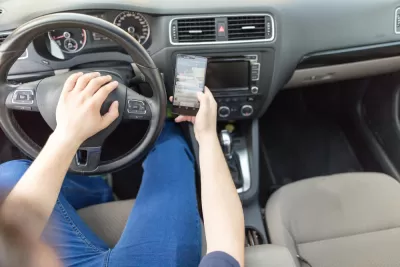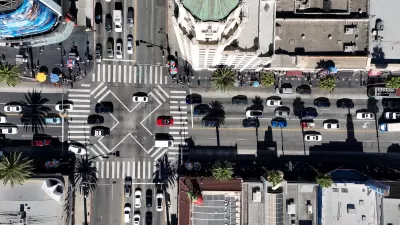Even with laws limiting or prohibiting the use of devices while driving, motorists continue to make calls and text while driving.

"Across the U.S., many states have distracted-driving laws in place. Yet federal studies estimate over 3,000 people a year die from distracted driving, and safety experts believe the actual number is far higher," reports a team from Bloomberg.
Data from smartphone apps that track drivers shed light on the extent of the problem. "New York drivers called, texted or swiped through apps about 22% of the time they were on the road. Los Angeles fared slightly worse, mostly in the 'non-call passive usage' category, which could include the use of apps for navigation and directions."
Over the course of this year, distracted driving appears to have leveled out, possibly due to the implementation of new state laws and public information campaigns. However, laws are inconsistent across the country. For example, all states except Missouri and Montana have full bans on texting while driving, but laws limiting use of handheld devices while driving are a mix of full and partial bans with no restrictions at all in some states.
"The data support the generally-accepted wisdom that despite laws, penalties and reminders of the hazards of cell phone distractions while behind the wheel, drivers continue to put themselves and others on America’s roads in grave danger."
FULL STORY: Drivers Refuse to Put Down Their Phones. People Keep Dying.

Alabama: Trump Terminates Settlements for Black Communities Harmed By Raw Sewage
Trump deemed the landmark civil rights agreement “illegal DEI and environmental justice policy.”

Study: Maui’s Plan to Convert Vacation Rentals to Long-Term Housing Could Cause Nearly $1 Billion Economic Loss
The plan would reduce visitor accommodation by 25% resulting in 1,900 jobs lost.

Why Should We Subsidize Public Transportation?
Many public transit agencies face financial stress due to rising costs, declining fare revenue, and declining subsidies. Transit advocates must provide a strong business case for increasing public transit funding.

Wind Energy on the Rise Despite Federal Policy Reversal
The Trump administration is revoking federal support for renewable energy, but demand for new projects continues unabated.

Passengers Flock to Caltrain After Electrification
The new electric trains are running faster and more reliably, leading to strong ridership growth on the Bay Area rail system.

Texas Churches Rally Behind ‘Yes in God’s Back Yard’ Legislation
Religious leaders want the state to reduce zoning regulations to streamline leasing church-owned land to housing developers.
Urban Design for Planners 1: Software Tools
This six-course series explores essential urban design concepts using open source software and equips planners with the tools they need to participate fully in the urban design process.
Planning for Universal Design
Learn the tools for implementing Universal Design in planning regulations.
Caltrans
Smith Gee Studio
Institute for Housing and Urban Development Studies (IHS)
City of Grandview
Harvard GSD Executive Education
Toledo-Lucas County Plan Commissions
Salt Lake City
NYU Wagner Graduate School of Public Service




























